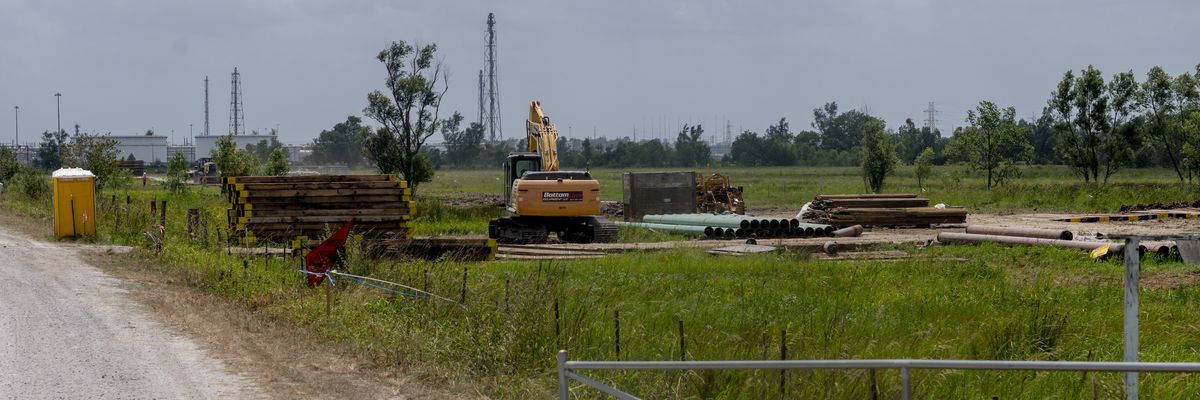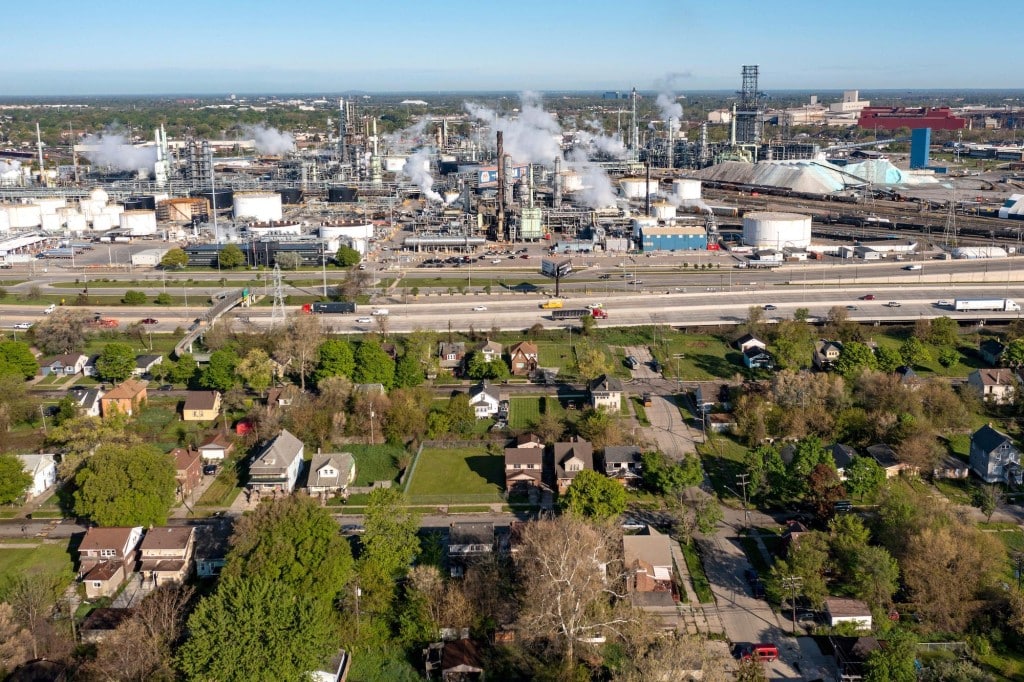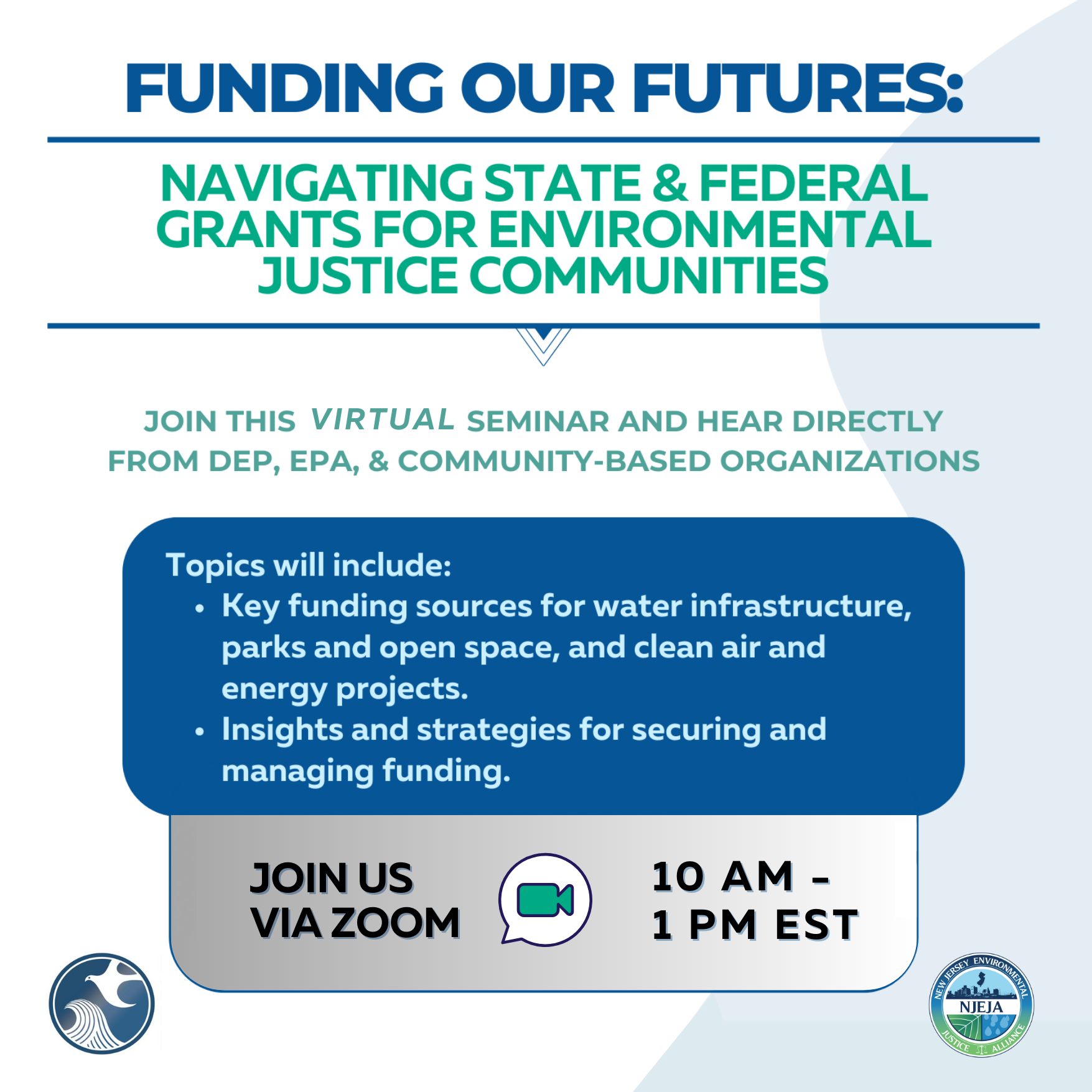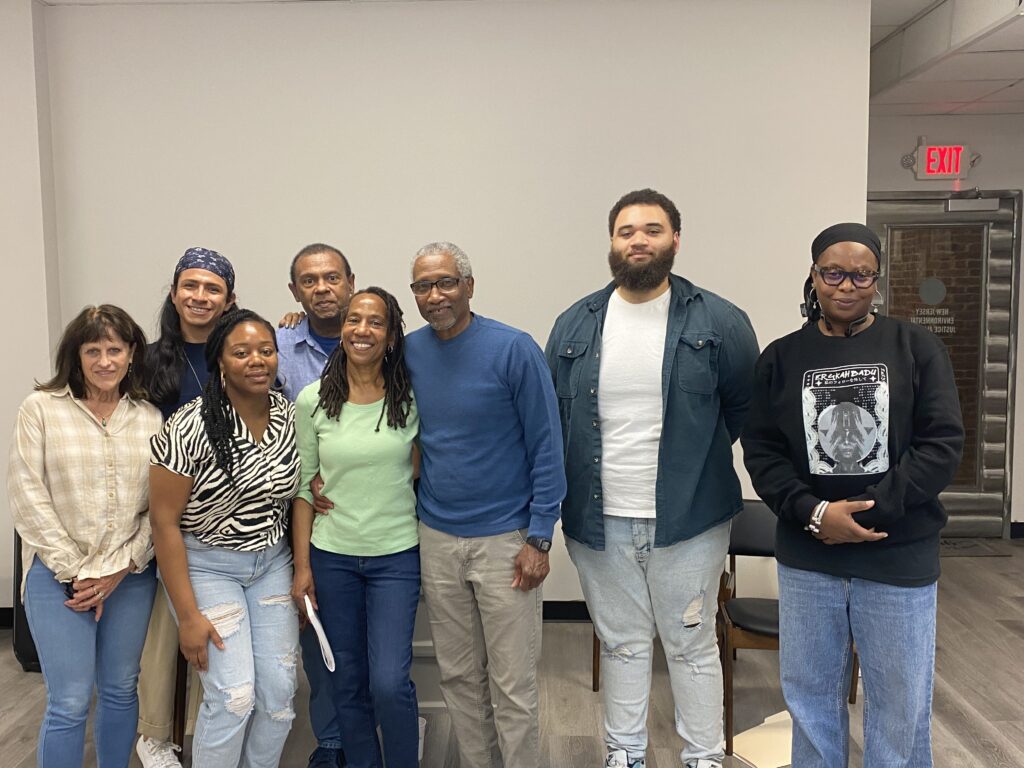We are excited to invite you to a Community Listening Session on Waste Issues in Camden! The purpose of these sessions is to listen to what Environmental Justice community members have to say about waste-related injustices and issues they are experiencing in their communities.
Continue readingPress Release: Protect EJ Communities While Mitigating Climate Change
Funding Our Futures
There is an unprecedented amount of environmental justice funding allocated for organizations and the window to access these dollars is closing. Recognizing the urgency of the moment, we are excited to partner with the NJ Department of Environmental Protection to host Funding Our Futures: Navigating State and Federal Grants.
UPDATE: Due to weather concerns, we’ve decided to shift #FundingOurFutures seminar to a virtual webinar.
Join us via Zoom!
Comments to the Dept. of Treasury on Credits for Hydrogen Production
To date, climate change mitigation policy has typically been carbon-centric and focused solely on reducing carbon emissions. We urge the 45(v) tax credit proposed rule to move away from carbon centrism by addressing EJ issues that include limiting the emissions of GHG co-pollutants in general as much as possible.
A carbon centric approach and focus on solely using the lifecycle GHG emissions rate of hydrogen production as the metric to determine whether the hydrogen produced is “clean”, is a significant EJ concern. This approach ignores the emissions of GHG co-pollutants along the life cycle of not just hydrogen production but storage, delivery and end uses (such as the burning of hydrogen-blended natural gas at power plants3). Additionally, when a life cycle GHG emissions rate is the sole metric to determine whether the hydrogen produced is clean, a myriad of environmental and health impacts along the hydrogen production chain remain insufficiently addressed.
NJEJA Celebrates Success of Inaugural Offshore Wind Training Program
Nicky Sheats, Ph.D., Receives Governor’s Environmental Excellence Award
This article was originally published by Kean University on December 19, 2023.

The Director of the Center for the Urban Environment at Kean University’s John S. Watson Institute, Nicky Sheats, Ph.D., received a 2023 Governor’s Environmental Excellence Award, a premier honor recognizing outstanding environmental work in New Jersey.
Sheats, an attorney, scholar and leader in the environmental justice community, received the award in the category of environmental justice on December 18 in Trenton.
“It is an honor to receive the award, which I feel is really in recognition of what the New Jersey environmental justice community has accomplished together,” Sheats said. “This is important work.”
Sheats was one of 12 environmental leaders receiving awards.
“The achievements of this year’s award winners capture the essence of environmentalism in New Jersey and set a shining example for us all to follow,” said state Department of Environmental Protection Commissioner Shawn LaTourette. “It’s an honor to celebrate their determined efforts to protect the state’s natural resources and help others connect to nature.”
Sheats was recognized for his instrumental role in the development and passage of New Jersey’s landmark environmental justice law, and his work establishing pollution reduction policies.
“His recent efforts seek to integrate environmental justice in climate mitigation policies called Mandatory Emissions Reductions (MER) that target reductions of associated co-pollutants, along with greenhouse gas emissions, and which impact overburdened communities,” DEP said in a statement.
Sheats convened the state’s first MER policy workgroup with the New Jersey Environmental Justice Alliance, and was lead author of a recently published paper exploring the implementation of MER policies in New Jersey, Minnesota and Delaware.
At the Watson Institute for Urban Policy and Research, Sheats provides leadership on environmental justice, and scientific, legal, financial and other issues affecting communities throughout the state and nation.
Kean Senior Vice President for Transformational Learning and External Affairs Joseph Youngblood, Ph.D., said Sheats has been a “visionary” leader for 20 years as director of the Center for the Urban Environment.
“Dr. Sheats was a pioneering researcher and policy expert in the environmental justice movement in America,” Youngblood said. “His work at Kean’s Watson Institute has informed state and federal policies that mitigate the cumulative impacts of environmental hazards and eliminate the disproportionate impact of environmental racism on communities of color. His life’s work and influence will have a lasting impact on society.”
Sheats said key areas being addressed from an environmental justice standpoint are cumulative impact of pollutants on neighborhoods; climate change mitigation policy that ensures communities are benefitted, rather than harmed, as they fight climate change; chemical policy and waste policy.
Sheats said credit also goes to the New Jersey Environmental Justice Alliance, the Tishman Environment and Design Center of the New School, the Ironbound Community Corporation, the South Ward Environmental Alliance and the Center for the Urban Environment.
It’s Time We Put an End to the Carbon Capture Farce

Motiva, another plant involved with a carbon capture project, lays out new built pipes in Donaldsonville, Louisiana, on June 19, 2023. (Photo: Emily Kask for the Washington Post)
This article was originally published by Common Dreams on November 14, 2023.
By: Ana Baptista, Dana Johnson
The transition away from fossil fuels is an urgent necessity, but we must ensure that renewable energy development doesn’t leave anyone behind. Environmental justice communities need real change – not a rebrand of the same discriminatory plans that slow the clock on fighting the climate crisis and reinforce the status quo.
There is a heightened focus on justice and equity in the Biden administration—but what does that look like for communities living with the realities of systemic and institutionalized discrimination?
For generations, environmental justice communities have borne the brunt of policies and practices that have relegated our homes, workplaces, recreational spaces, and places of worship to the shadows of fossil fuel and petrochemical infrastructure. As the administration and lawmakers advance opportunities to “decarbonize” the energy sector—the largest source of climate change-causing greenhouse gases in the U.S.—many communities are given little insight into the plans and technologies marketed as the solution. As a result, environmental justice communities—those predominantly composed of people of color and those with low income—have to navigate a maze of new federal investments in obscure policies and plans.
Specifically, carbon capture and sequestration (CCS), utilization (CCUS), hydrogen hubs, and direct air capture projects are being rolled out without transparency and our communities are targeted as development zones. It’s time for real change—not a rebrand of the same discriminatory plans that slow the clock on fighting the climate crisis and reinforce the status quo.
While CCS is being pushed as a way to cut emissions, it’s actually enabling further fossil fuel reliance.
The emergence of carbon management initiatives, including the Environmental Protection Agency’s (EPA) latest carbon rule proposal in tandem with the Department of Energy’s (DOE) regional hydrogen hub plan, are a major part of the problem. These initiatives are based on the promise of siphoning off greenhouse gas emissions from power plants and industrial facilities, but they often rely more on greenwashing and wishful thinking than on real solutions. They divert focus from the critical need to break free from fossil fuels, such as coal and natural gas, that disproportionately burden environmental justice communities.
The reality is that CCS technology remains untested at scale, is not guaranteed to work, and won’t address other harmful pollution like particulates that wreak havoc on our communities. In fact, “…more than 95% of all deployed CCS capacity has been used for enhanced oil recovery (‘EOR’), the process of taking captured carbon dioxide (CO2) and injecting it back into depleted oil wells to further extract more fossil fuels.”
While CCS is being pushed as a way to cut emissions, it’s actually enabling further fossil fuel reliance. What’s even more infuriating is that these projects are poised to reap the benefits of federal tax credits bolstered by the Inflation Reduction Act of 2022. This is a con job on the American public that will funnel funds into risky projects ultimately helping fossil fuel companies and perpetuating the systems that caused the climate crisis.
Now, CCS, CCUS, and direct air capture, along with certain types of hydrogen hubs using CCS along with natural gas, are planned for locations already overburdened by heavy industry, imposing additional risks such as leaks, pipelines blowing up, and health-harming air pollution like nitrogen oxide emissions. Unfortunately, a staggering 90% of the proposed or existing CCS/CCUS plants are located in or dangerously close to EJ communities. This means that investments in these risky schemes will inflict more damage on those already most vulnerable to pollution and climate change for years to come. Louisiana alone faces over two dozen proposals for CCS, CCUS, and hydrogen projects.
If these energy plans move forward, EJ communities will again be collateral damage.
One of these is a colossal $4.5 billion hydrogen plant and carbon capture complex in Ascension Parish by Air Products. This project includes carbon pipelines, wells, and underground storage that pose a grave threat to Lake Maurepas and contribute to air pollution from the new CCS plant, along with the real possibility of explosions. To make matters worse, project applicants may only carry liability for 10 years instead of the usual 50, leaving one of the poorest states with potential liabilities indefinitely.
Federal agencies promise new “regulatory regimes,” to protect EJ communities, but all we see in response to our concerns is an offering of community benefit agreements and public engagement processes that lack substantial, enforceable protections or the right to say “no.” In the absence of concrete federal protections, speculative industry proposals will capitalize on generous federal incentives like the 45Q and 45V tax credits, which allow upfront benefits without a clear mechanism by which governments will oversee and ensure the permanent storage of CO2. Likewise, the Inflation Reduction Act lengthened application timelines and opened up the criteria for which CCS projects qualify. And when disasters hit, we’ll all pay the price through skyrocketing healthcare and housing costs, along with other rising costs linked to pollution and the climate crisis. This approach not only rewards the industries that drive climate change and pollution in EJ communities, but it also perpetuates the big scam of oil, gas, and petrochemical giants.
It’s time we put an end to this farce.
EJ communities were given promises for real investment and involvement in a just energy transition through the administration’s Justice40 Initiative that would not mirror prejudicial policies of the past. If these energy plans move forward, EJ communities will again be collateral damage. There are sustainable solutions that desperately need our support and funding, including transitioning to truly clean, renewable energy such as wind and solar with an equitable transmission build-out.
We have what we need to do right by EJ communities nationwide, and to stave off the worst of the climate crisis before it’s too late—it’s time to move in the right direction.
2023 Fall Film Series: Exploring the Intersections of Environmental Justice
What Michigan Could Learn from New Jersey’s 2020 Cumulative Impact Law
This article was originally published by Planet Detroit on September 28, 2023.
By: Brian Allnut
Experts say all Michigan residents could benefit from the transparency in the Garden State’s pollution rules for overburdened communities.

Theresa Landrum has been fighting for environmental justice in Detroit’s heavily polluted 48217 zip code for decades, where residents suffer from disproportionate rates of asthma, cancer, respiratory problems, heart disease, miscarriages, and birth defects, all of which are associated with air pollution.
Yet companies like Marathon Petroleum and Edward C. Levy continue to pursue permits that could bring even more pollution.
Landrum said this year’s wildfire smoke worsened the bad air, turning the sky orange and leaving her coughing for days. Indeed, new research shows that although the nation’s air quality had improved following the passage of the Clean Air Act in 1970, in many states wildfire smoke has slowed or reversed much of this progress over the last two decades.
But, she said, the new smoke threat could bring more urgency to efforts to control air pollution from other sources. “We’re not looking at cumulative impacts from all these industries,” she said.
Activists like Landrum are focused on the collective impact of pollution from multiple sources, often concentrated in low-income areas and communities of color such as southwest Detroit. Facilities are regulated on a case-by-case basis, although a permit could be denied if it will increase the level of one of six pollutants covered by the National Ambient Air Quality Standards and the area is already out of compliance for that pollutant.
This approach can allow for a heavy overall pollution burden, even though individual businesses are operating within legal emissions limits.
The concept of regulating cumulative impacts is slowly gaining traction. In January, the U.S. Environmental Protection Agency released guidance outlining its authority to consider cumulative impacts in its decisions. And at least 12 state legislatures have considered or adopted legislation addressing cumulative risk or impacts, according to a University of Michigan analysis released last year.

To address this issue in Michigan, Landrum is working with a statewide coalition of environmental groups to push for cumulative impact legislation, influenced by New Jersey’s landmark 2020 environmental justice law that restricted the issuing of new permits or expansion of facilities in overburdened communities.
Michigan could learn from the approach organizers took in New Jersey, advocates say. There, activists worked for years on legislation that was finally passed when the Black Lives Matter movement and public health concerns related to COVID helped galvanize support.
Yet, advocates say passing a law in Michigan may require a slightly different approach, with a need to build support in both urban and rural areas to challenge a powerful industrial lobby in a state where Democrats hold a slim majority in the legislature.
“The health impacts, the air quality impacts, the water quality impacts are something that both rural people and urban folks that are on the fence line of big industry are dealing with,” said Christy McGillivray, legislative and political director for the Sierra Club Michigan Chapter.
She said a smart strategy in Michigan could look at the impacts of industrial agriculture and other industries in farm country as well as urban pollution to build a broad constituency for a cumulative impact bill.
New Jersey sets a precedent
Melissa Miles, executive director of the New Jersey Environmental Justice Alliance, said New Jersey’s 2020 law came at the end of a years-long effort to bring more protections for overburdened communities in the state.
“EJ groups never dropped that banner of cumulative impacts, even when it was unpopular, even when there wasn’t political will,” Miles said.
She said the key to getting the New Jersey law over the finish line were the specific circumstances of 2020 that brought justice concerns to the fore.
“This moment happened nationally that was heard around the world, which was the Black Lives Matter movement,” Miles said. “When Black people say, ‘we can’t breathe,’ it could be the result of the quick, violent deaths at the hands of law enforcement, or it could be the slow, silent death due to air pollution.”
The disproportionate impacts from COVID-19 in Black and brown communities also highlighted the relationship between particulate matter pollution and poor health outcomes during the pandemic.
Miles said New Jersey environmental justice advocates were ready to help inform policy-making when these tragic circumstances created an appetite for reform.
The result was legislation with key cumulative impact provisions. The law gave the state’s Department of Environmental Protection a mandate to deny permits for certain types of facilities like incinerators and sewage treatment plants seeking to locate in areas already burdened by pollution. It also required businesses to perform a cumulative impact analysis for new projects or expansions and gave the public more opportunities to influence permit applications.
Jonathon J. Smith, an attorney with the nonprofit Earthjustice, said demographic information, including race, income, and limited English proficiency, was used to help define an “overburdened” community.
And industry was barred under the law from using the promise of jobs as a reason to put a polluting facility in an overburdened community.
This last piece gets at a common practice in Michigan. For example, Stellantis used jobs to make the case for expanding its polluting facilities on Detroit’s east side. This project received$400 million in tax incentives and at least 12 odor violations since it opened in June 2021.
After New Jersey’s law was passed, Miles said her group worked to prevent industry from undermining the legislation and ensuring residents were available to influence the new rules when regulators put them together. However, New Jersey only began enforcing the law in April 2023 and Smith said the state will have to wait and see how much regulators are “taking it to heart”.
How Michigan could get it done
Trent Wolf, who recently served as the senior advisor to Michigan House Majority Floor Leader Abraham Aiyash (D-Hamtramck), told Planet Detroit that Aiyash and State Sen. Stephanie Chang (D-Detroit) are crafting cumulative impact legislation that can stand up to litigation or constitutional challenges.
In the wake of the Supreme Court’s decision to end race-based affirmative action in college admissions, environmental justice laws that use race as a criterion for defining an overburdened community could be open to legal challenges.
This ruling may have prompted the Environmental Protection Agency to drop a civil rights complaint into Louisiana’s permitting of industries in a heavily polluted area known as “cancer alley”.
Nick Schroeck, an environmental law expert at Detroit Mercy School of Law, said state programs that incorporate race as a factor in decision-making are less vulnerable to challenges than federal ones, although the language still needs to be drafted carefully.
Wolf said the White House’s Justice40 program, which seeks to direct 40 percent of federal climate-related funding to disadvantaged communities, could also provide a template for crafting a bill. This program excluded race when defining target areas, using other criteria as a proxy for disadvantaged communities of color. However, the screening tool used by the programs has had only mixed success in identifying these areas so far.
Previously, Michigan advocates have said the Michigan Department of Environment, Great Lakes, and Energy (EGLE) already has the power under Rule 901 and Rule 228 to consider cumulative impacts, at least from air pollution, and deny permits.
EGLE spokesperson Hugh McDiarmid said the powers provided by these rules were limited and that the agency’s air quality division “does not have the ability to do cumulative impact analysis incorporating all ways a person may be exposed to pollutants [but that] the program is designed to minimize potential health impacts of the air emissions from facilities on nearby residents.”
In Michigan, the first step toward creating a law that explicitly requires the agency to consider cumulative impacts may be engaging with impacted communities to raise awareness and get input on proposed legislation.
“For this legislation to move, it’s going to take a lot of work at the grassroots level of getting people engaged and understanding that legislation like this can have a deep impact in their community,” Wolf said. “This is a relatively new concept.”
Wolf also believes there’s the potential for urban advocates to build a coalition with rural people dealing with factory farms and facilities like chemical recycling centers and battery plants.
Pam Taylor, a farm owner in rural Lenawee County who leads the water testing program for the nonprofit Environmentally Concerned Citizens of Southeast Michigan, has been working for decades to address water quality problems created by the manure-laden discharge from industrial livestock farms. This pollution has contributed to potentially life-threatening toxic algal blooms downstream, like the 2014 Lake Erie bloom that shut down Toledo’s drinking water supply for several days.
In the past, Taylor has helped lead tours with the Sierra Club to highlight toxic industries in Detroit and Lenawee County, showing the public and mental health problems that occur when industry concentrates in certain areas.
Taylor said her sparsely populated community roughly 60 miles southwest of Detroit resembles other areas where scarce jobs and poverty drive people to work in industries that may compromise their health.
“There aren’t that many jobs, so people end up working for these big factory farms even though they hate it,” she said. “It’s basically a captured community, just like a mining community would be Appalachia.”
Taylor said a cumulative impact bill would reduce the impact of these farms on local waterways and protect groundwater. She said that as waterways have become more polluted, communities have turned to groundwater for drinking water, a resource threatened by water-hungry industrial farms.
“A cumulative impact bill would be wonderful,” Taylor said. “It would reduce the chance of so many of these farms being crammed together in one area.”
Pushback from industry
Michigan’s powerful industrial lobby, including automakers, utilities, and chemical companies, will likely fight against a cumulative impact bill that could add new business costs.
Mike Alaimo, director of environmental and energy affairs at the Michigan Chamber of Commerce, said cumulative impact laws would add new requirements for businesses that could hurt job creation and get in the way of rebuilding the state’s aging infrastructure.
“Cumulative impacts is kind of this whole new bureaucratic layer that would function on top of an already challenging and burdensome system,” he said. “Adding more burden, just adding more regulatory costs, will simply drive businesses away.”
He said these costs could undermine technology like carbon capture, which could be used to reduce emissions from fossil fuel power plants. That technology has been challenged by environmental advocates for its potential to increase non-CO2 greenhouse gas emissions like nitrogen oxides and particulate matter as well as creating possible safety issues.
And if investment is pushed away from areas of concentrated industry, Alaimo said it could lead to developing greenfield areas instead of cleaning up contamination and redeveloping brownfield sites.
Schroeck said Michiganders have good reasons to support a cumulative impact law, even if they feel relatively protected from pollution. He said the transparency and cumulative impact assessments offered by a law like New Jersey’s could shed light on pollution issues residents may not be aware of, helping influence statewide permitting and protecting public health.
“I don’t think any of us are really safe,” Schroeck said. “To the extent that we can provide more data and more transparency, I think that will help the public at large to understand the benefits and also the costs of the way that we have been doing business.”
He adds that a healthier population is better for everyone, lowering healthcare costs and insurance rates. But Schroeck said that legislation could be stymied by a lack of knowledge among lawmakers and residents about the health impacts from pollution and the culture war framing of environmental justice that he said paints the issue as “a liberal pet project.”
Lawmakers also have a poor record of being proactive with environmental legislation, Schroeck said.
“We’re much better at, like looking backwards, coming up with cleanup standards and things, than we are at actually preventing harm in the first place,” he said.
He agrees with Landrum in southwest Detroit that more summers with wildfire smoke could create renewed urgency to manage air pollution as much as possible, changing the political calculus around cumulative impacts.
For now, Landrum says environmental advocates need to keep raising the issue until an opportune moment arrives to pass a bill like what happened in New Jersey.
“The intention is to keep putting it out there,” she said.
Op-Ed: Striving for Plastic-Free Communities in NJ
This article was originally published by NJ Spotlight News on August 9, 2023.
By: Jason Ajiake, Chris Tandazo
Although it’s typically posited as a consumer problem, reducing plastic output is the responsibility of producers — a situation that has a grave impact on environmental justice.
Plastic has become an escalating global crisis that is impossible to ignore. Its presence can be found everywhere, from rivers and oceans to human blood and breast milk. As we collectively confront this mounting challenge, we must acknowledge that plastic pollution affects communities differently, depending on race, socio-economic status, access to health care and ZIP code. Communities most familiar with its direct impacts are often of color and low income. Any solution to address this crisis must be intersectional and recognize the interconnectedness between a plastic-free future and the pursuit of environmental justice.
From the extraction of fossil fuels to the exposure of toxic chemicals and the eventual disposal of plastic waste at incinerators, landfills or the environment, plastics disproportionally expose these environmental justice communities to harmful pollutants. For example, our environmental justice partners in the South and the Gulf Coast are actively fighting against the petrochemical industries sited in their communities. This is where the plastic crisis starts, in places like Cancer Alley in Louisiana, where the presence of petrochemical industries has exposed Black communities to high rates of cancer-related illnesses and deaths.
The current disposal of plastic waste is a continuation of the environmental racism that allows for the siting of incinerators and petrochemical industries in the most overburdened communities throughout the country. Research shows that eight out of 10 incinerators nationwide are located in majority-BIPOC, immigrant and low-income communities.
The plastic crisis arrives at our front door in environmental justice communities like Camden, Rahway and Newark, where plastic waste is burned alongside all other types of waste. New York City alone spends $448 million exporting its waste out of the city. Some of this waste leaves the state and goes to the Covanta incinerator in Newark. Burning plastic waste exposes us to toxic ash and pollutants, increasing the risk of cardiovascular and respiratory-related illnesses — posing a significant threat to frontline communities living near these facilities.
Recyclable? Not really
While plastic is promoted as a recyclable material, it cannot be easily recycled due to its toxic chemical composition (particularly single-use plastics). It’s become clear that we cannot recycle our way out of the plastic problem, mainly since less than 6% of plastic in the United States is recycled. As the production of plastic designed for recycling decreases, the generation and disposal of plastic waste increases at incinerators or landfills in environmental justice communities. Major polluters cleverly tout greenwashing terms like “chemical recycling,” “advanced recycling,” “waste-to-energy” and “plastic-to-fuel” as groundbreaking methods for “recycling” and “repurposing”plastic. In reality, they amount to nothing more than disguised forms of waste burning.
Although plastic waste is commonly portrayed as a consumer problem, it’s essential to recognize that reducing plastic output rests in the hands of its producers — and we know that they will not do this on their own. This is why policy intervention and community organizing are necessary to drive change and hold the manufacturers of plastic accountable.
In New Jersey, implementing the Single Use Waste Reduction Act has created a tangible way to encourage reuse practices and reduce the use of plastic bags, polystyrene food containers, paper bags and straws. Since implementation, the number of bags collected on New Jersey beaches has dropped by 37%. Plastic straws also decreased by 39%, and polystyrene takeout containers decreased by 38%, according to a recent Beach Sweeps Report, proving that bans on plastic can be effective at curbing plastic waste.
At the state level, well-written Extended Producer Responsibility (EPR) laws can be a vital tool to significantly reduce the current plastic waste stream and improve recycling goals. EPR laws shift plastic production, consumption, and disposal accountability from the consumer to the plastic producers while also preventing the push of false solutions like chemical recycling. Most recently, California and Colorado passed EPR laws last year.
If not for policy intervention, plastic waste will continue to be incinerated or landfilled in environmental justice communities where these facilities primarily exist. Prioritizing the implementation of policies that hold polluters accountable will pave the way for a sustainable and healthy, waste-free future. In the meantime, the advocacy and organizing required to address the plastic crisis and tackle the deep-rooted environmental racism that has persisted for so many decades continues.






